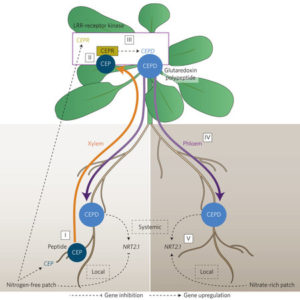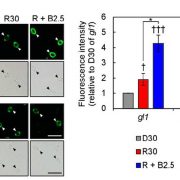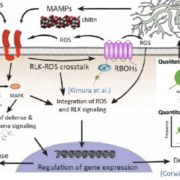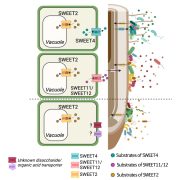Shoot-to-root mobile polypeptides involved in systemic regulation of nitrogen acquisition ($)
 To balance nutrient uptake (usually from heterogeneous sources) with nutrient demand, plants use a root-shoot-root signaling pathway. Previously, a root-to-shoot mobile peptide C-TERMINALLY ENCODED PEPTIDE (CEP) was shown to translocate from N-starved roots to the shoot, where it interacts with a leucine-rich repeat receptor kinase, CEP Receptor 1 (CEPR1). Ohkubo et al. identified two peptides, CEP DOWNSTREAM1 (CEPD1) and CEPD2, that act downstream of CEP-activated CEPR1 and that translocate from shoot to root. CEPD1/2 induce expression of the nitrate transporter NRT2.1 only in roots growing in the presence of nitrate. Therefore, N-starved roots are able to induce nitrate uptake in other roots via this root-shoot-root signalling module: Root-localized CEP sensor detects local N-starvation, ascends to the shoot as a signal, where it induces expression and action of CEPD polypeptides that then translocate to all roots, signaling N demand and resulting in the induction of N-uptake. (Summary by Tyra McCray) Nature Plants 10.1038/nplants.2017.29
To balance nutrient uptake (usually from heterogeneous sources) with nutrient demand, plants use a root-shoot-root signaling pathway. Previously, a root-to-shoot mobile peptide C-TERMINALLY ENCODED PEPTIDE (CEP) was shown to translocate from N-starved roots to the shoot, where it interacts with a leucine-rich repeat receptor kinase, CEP Receptor 1 (CEPR1). Ohkubo et al. identified two peptides, CEP DOWNSTREAM1 (CEPD1) and CEPD2, that act downstream of CEP-activated CEPR1 and that translocate from shoot to root. CEPD1/2 induce expression of the nitrate transporter NRT2.1 only in roots growing in the presence of nitrate. Therefore, N-starved roots are able to induce nitrate uptake in other roots via this root-shoot-root signalling module: Root-localized CEP sensor detects local N-starvation, ascends to the shoot as a signal, where it induces expression and action of CEPD polypeptides that then translocate to all roots, signaling N demand and resulting in the induction of N-uptake. (Summary by Tyra McCray) Nature Plants 10.1038/nplants.2017.29









Leave a Reply
Want to join the discussion?Feel free to contribute!